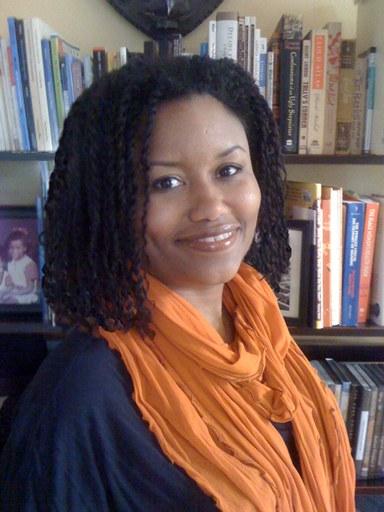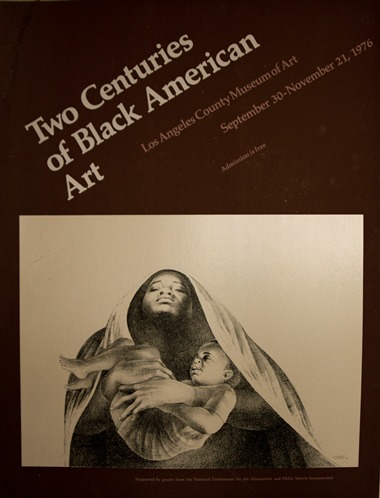I recently invited Dr. Bridget Cooks to be a panelist in this coming Saturday’s program, Two Centuries of Black American Art: A 35th Anniversary Roundtable, which will revisit this seminal LACMA exhibition. Dr. Cooks, Assistant Professor of Art History and African American Studies at University of California, Irvine, and a former LACMA educator, is the author of the forthcoming book Exhibiting Blackness: African Americans and the American Art Museum and dedicated a chapter in her study to the show: “Filling the Void: Two Centuries of Black American Art (1976).” An excerpt from that chapter will be an integral part of our soon-to-be-launched online archive for this historic exhibition, and the cover image for her book was shot in LACMA’s American Art galleries. I sat down with Bridget when she was here planning the cover shoot to learn more about her work and her connections with LACMA.
Austen Bailly: When we were first in touch, you told me you were a LACMA neighborhood kid, which I loved. Can you tell me about your early experiences at the museum? Is there a particular LACMA memory that stands out from your childhood?
Bridget Cooks: My mother used to take my sister and me here often. We’d pack a picnic and walk here from home. We lived a couple of miles away, and we would sit by the Page Museum and have lunch, and we’d bring a hula hoop and play games and roll down the hills, and look at the art in the museum. I have to say that one of my earliest memories of LACMA, in the galleries, was the King Tut show, which I think was 1977. I remember my mother holding me up so I could see all of the jewelry in the cases; that’s really one of my earliest memories, ever, of anything. I remember looking down at the jewelry because she lifted me up so high.
AB: As a former member of LACMA’s Education Department, you created the programming for the museum’s landmark exhibition Made in California (2000). How did that experience inform your book?
BC: The book is based on a lot of primary research, oral histories, and archival work, and was really inspired by my experience as a museum educator and professional. There were so many things that I learned about when I was working in museums about how museums work, the kinds of conversations we have about cultural history and cultural memory; the kind of responsibility that museums have to the community; the kind of narratives we tell. I really wanted to write books about that sort of behind-the-scenes process. Programming for Made in California was about crafting a narrative, trying to reflect everyone’s California—which is a really impossible thing to do—but to try to bring out some of the stories that are not as familiar to everyone, and also capitalizing on common experiences that we all have. In the Education Department I learned a lot about the different layers of memory, the desires that different audiences have of LACMA in particular and museums in general. And those stories, that whole process is just endlessly fascinating to me. That’s definitely been an inspiration for the book.
AB: Tell me about your vision for the book’s cover, which will show African Americans in LACMA’s American galleries.
BC: I have a very strong vision that I’m really excited about for the book, which will be published in August. I wanted to come to LACMA because it is really my museum—because I grew up here. I wanted to show some of the work that we have here in the American galleries, but also show the way that people interact with it, particularly African Americans—as guards, as visitors, and also as people who are imaged in the photographs, and in the paintings and the sculpture. I want to show an image that relays the kind of complexity of that relationship—the way that we have an African American presence in major mainstream museums.
AB: What do you think about the relationships between LACMA and its African American visitors today?
BC: I think that there are a lot of African American people in Los Angeles, and really across the nation, that remember the show Two Centuries of Black American Art and think about LACMA as a place where David Driskell [the guest curator] was able to bring his vision to the world, something that we’re all really proud of. And I think that might be the last really strong memory that the African American residents of Los Angeles really have of a strong black presence at the museum. I like that the work by black artists is interspersed, in their contexts, throughout the museum; I think that’s really wonderful. I don’t know if the black population that’s interested in art really knows that that’s here. I think they might be relieved and excited to see that there are black artists throughout the collection without a huge announcement or a show that’s just for black artists, but to see that we are becoming more and more integrated into the collection. I really like very much that on LACMA’s website you have a section where you can search and see African American artists that are collected. I think that’s an important part of that public relationship with the larger black community, so they can see that there’s recognition. But, I think, of course, more, more, more.




